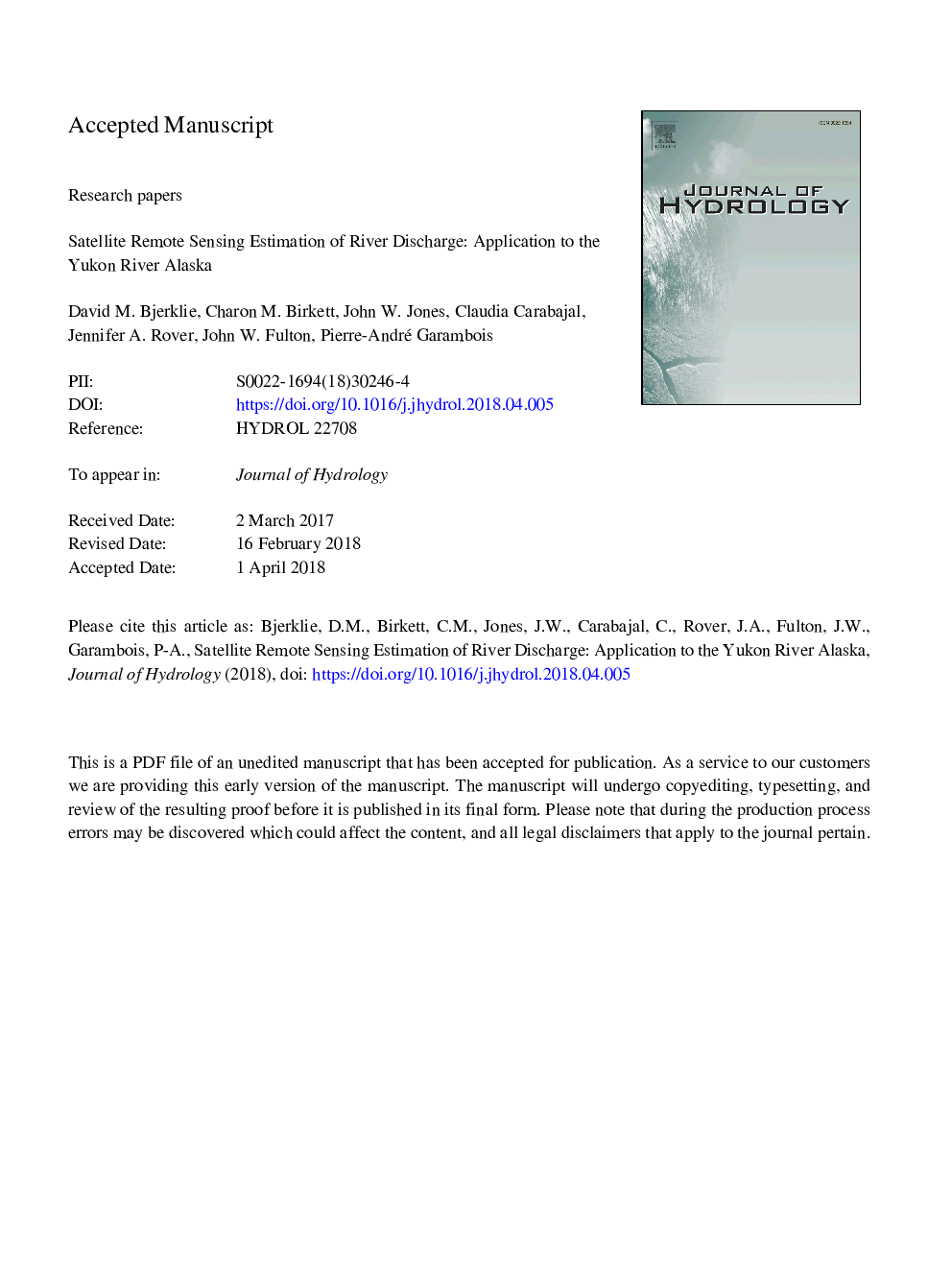| کد مقاله | کد نشریه | سال انتشار | مقاله انگلیسی | نسخه تمام متن |
|---|---|---|---|---|
| 8894910 | 1629893 | 2018 | 79 صفحه PDF | دانلود رایگان |
عنوان انگلیسی مقاله ISI
Satellite remote sensing estimation of river discharge: Application to the Yukon River Alaska
ترجمه فارسی عنوان
برآورد ماهواره ای از راه دور تخلیه رودخانه: کاربرد در رودخانه یوکون در
دانلود مقاله + سفارش ترجمه
دانلود مقاله ISI انگلیسی
رایگان برای ایرانیان
کلمات کلیدی
سنجش از دور، سطح آب لندست، ارتفاع آب آب جیسون-2، تخلیه رودخانه، یوکان رود آلاسکا،
موضوعات مرتبط
مهندسی و علوم پایه
علوم زمین و سیارات
فرآیندهای سطح زمین
چکیده انگلیسی
A methodology based on general hydraulic relations for rivers has been developed to estimate the discharge (flow rate) of rivers using satellite remote sensing observations. The estimates of discharge, flow depth, and flow velocity are derived from remotely observed water surface area, water surface slope, and water surface height, and demonstrated for two reaches of the Yukon River in Alaska, at Eagle (reach length 34.7â¯km) and near Stevens Village (reach length 38.3â¯km). The method is based on fundamental equations of hydraulic flow resistance in rivers, including the Manning equation and the Prandtl-von Karman universal velocity distribution equation. The method employs some new hydraulic relations to help define flow resistance and height of the zero flow boundary in the channel. Estimates are made both with and without calibration. The water surface area of the river reach is measured by using a provisional version of the U.S. Geological Survey (USGS) Landsat based product named Dynamic Surface Water Extent (DSWE). The water surface height and slope measurements require a self-consistent datum, and are derived from observations from the Jason-2 satellite altimeter mission. At both reach locations, the Jason-2 radar altimeter non-winter heights consistently tracked the stage recorded at USGS streamgages with a standard deviation of differences (error) during the non-winter periods of less than 7%. Part of the error may be due to differences in the gage and altimeter crossing locations with respect to the range of stage change and the response to changes in discharge at the upstream and downstream locations. For the non-winter periods, the radar derived slope estimates (meanâ¯=â¯0.0003) were constant over the mission lifetime, and in agreement with previously measured USGS water surface slopes and slopes determined from USGS topographic maps. The accuracy of the mean of the uncalibrated daily estimates of discharge varied between reaches, ranging from 13% near Stevens Village (Nâ¯=â¯90) to â21% at Eagle (Nâ¯=â¯246) based on the absolute error, and 5% to â6% based on the error of the log of the estimates. Calibrating to the mean of USGS daily discharge estimates from the streamflow rating for the same period of record at each streamgage resulted in mean absolute errors ranging from 1% to 2%, and log errors ranging from 1% or less. The error pattern of the estimates shows that without calibration, even though the mean is well simulated, the high and low end values over the range of estimates may have significant bias.
ناشر
Database: Elsevier - ScienceDirect (ساینس دایرکت)
Journal: Journal of Hydrology - Volume 561, June 2018, Pages 1000-1018
Journal: Journal of Hydrology - Volume 561, June 2018, Pages 1000-1018
نویسندگان
David M. Bjerklie, Charon M. Birkett, John W. Jones, Claudia Carabajal, Jennifer A. Rover, John W. Fulton, Pierre-André Garambois,
